
The Invalids' Cemetery is one of the oldest cemeteries in Berlin. It was the traditional resting place of the Prussian Army, and is regarded as particularly important as a memorial to the German Wars of Liberation of 1813–15.
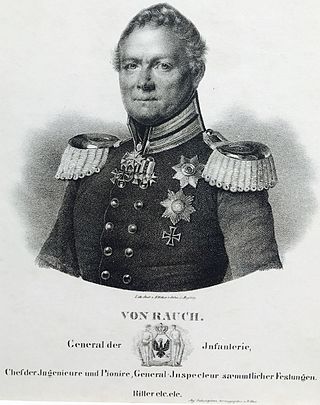
Johann Justus Georg Gustav von Rauch was a Prussian general of the infantry and Minister of War from 1837 to 1841.
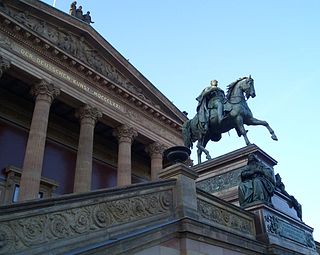
Alexander Emil Ludovico Calandrelli was a German sculptor of Italian descent.

General of the Cavalry was a General of the branch OF8-rank in the Imperial Army, the interwar Reichswehr, and the Wehrmacht. It was the second-highest General officer rank below Generaloberst. Artillery officers of equivalent rank were called General der Artillerie, and infantry officers of equivalent rank General der Infanterie. The Wehrmacht also created General der Panzertruppen, General der Gebirgstruppen, General der Pioniere (engineers), General der Flieger (aviators), General der Fallschirmtruppen, and General der Nachrichtentruppen

Gustav Bläser was a German sculptor.
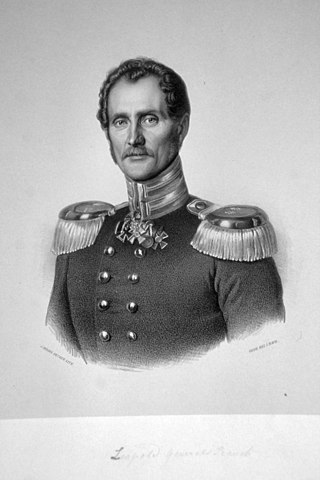
Gustav Adolf Leopold von Rauch was a major general in the Prussian Army.

Johann Bonaventura von Rauch was a Prussian Army major general. His sons Gustav, Leopold and Friedrich Wilhelm also took up military careers and became general as well.

Born into an aristocratic Prussian family, Albert Gustav Guido von Rauch was a general of the infantry in the Prussian Army who fought in the Austro-Prussian War and Franco-Prussian War.

Fedor Alexander Gustav von Rauch was a cavalry officer in the Prussian Army and son of the Prussian Minister of War and general of the infantry Gustav von Rauch.
Friedrich Wilhelm Gustav Claus von Rauch was an officer in the Prussian Army. He was the godson of Frederick III, German Emperor and the son of the General of the Infantry Albert von Rauch (1829–1901) and his wife Elisabeth, née von Bismarck (1845–1923). He became a military governor and tutor to Wilhelm II's sons.
Gustav Adolf von Rauch retired in 1854 as a cavalry officer with the rank of major in the Prussian Gardes du Corps regiment, to act as chamberlain and court-marshal to Princess Louise of Prussia, wife of Alexis, Landgrave of Hesse-Philippsthal-Barchfeld, who have been divorced since 1861, in the following decades at Berlin's Monbijou Palace. Rauch was a distinguished collector of ancient Greek and Roman coins and from 1870 to 1877 chairman of the Numismatic Society in Berlin.

Alfred Bonaventura von Rauch was a general of the cavalry in the Prussian Army and an amateur jockey. He was born in Potsdam and died in Berlin.

Nikolaus Georg Gustav von Rauch was an Oberst and cavalry officer in the Prussian Army.

The Scharnhorst Memorial on Unter den Linden avenue in Berlin's Mitte district commemorates the Prussian military reformer and freedom fighter Gerhard von Scharnhorst (1755–1813). Created from 1819 to 1822 by Christian Daniel Rauch in neoclassical style, it is a masterpiece of the Berlin school of sculpture.

The Bülow Memorial on Unter den Linden avenue in Berlin's Mitte district commemorates the Prussian army general and freedom fighter Friedrich Wilhelm Bülow von Dennewitz (1755–1816). Created from 1819 to 1822 by Christian Daniel Rauch in neoclassical style, it is a masterpiece of the Berlin school of sculpture.
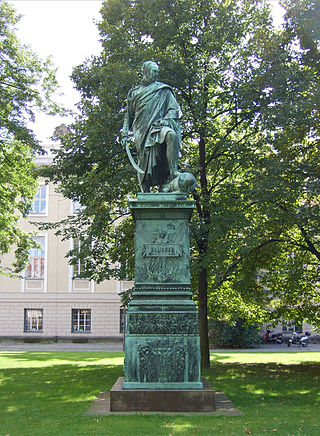
The Blücher Memorial on Bebelplatz green space in Berlin's Mitte district commemorates the Prussian field marshal and freedom fighter Gebhard Leberecht von Blücher (1742–1819). Created from 1819 to 1826 by Christian Daniel Rauch in neoclassical style, it is a masterpiece of the Berlin school of sculpture. Until 1950 the bronze statue stood at the front of Unter den Linden avenue, with which it formed an urban ensemble, and since 1963 it has stood at the back of the current location.
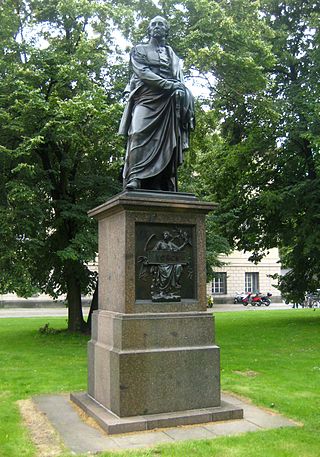
The Yorck Memorial on Bebelplatz green space in Berlin's Mitte district commemorates the Prussian field marshal and freedom fighter Ludwig Yorck von Wartenburg (1759–1830). Created from 1840 to 1855 by Christian Daniel Rauch in neoclassical style, it is a piece of the Berlin school of sculpture. Until 1950 the bronze statue stood at the front of Unter den Linden avenue, with which it formed an urban ensemble, and since 1963 it has stood at the back of Bebelplatz green space.

The Gneisenau Memorial on Bebelplatz green space in Berlin's Mitte district commemorates the Prussian field marshal and freedom fighter August Neidhardt von Gneisenau (1760–1831). Created from 1840 to 1855 by Christian Daniel Rauch in neoclassical style, it is a piece of the Berlin school of sculpture. Until 1950 the bronze statue stood at the front of Unter den Linden avenue, with which it formed an urban ensemble, and since 1963 it has stood at the back of Bebelplatz green space.
This page is based on this
Wikipedia article Text is available under the
CC BY-SA 4.0 license; additional terms may apply.
Images, videos and audio are available under their respective licenses.
















